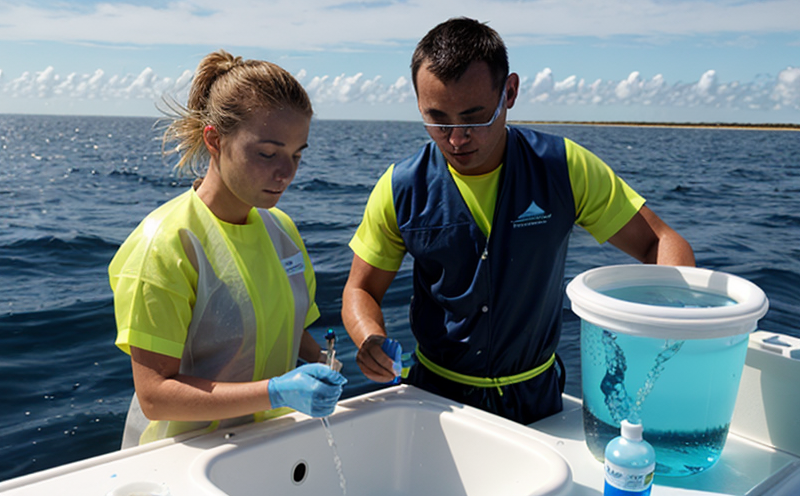ASTM D3557 Chromium Test in Seawater
The ASTM D3557 procedure provides a standardized method for determining hexavalent chromium (Cr(VI)) concentrations in seawater. This testing is crucial for monitoring environmental compliance, especially in regions where coastal industries discharge treated wastewater into the marine environment. Hexavalent chromium can pose significant risks to both aquatic life and human health when present at high levels.
Chromium exists in two main forms: trivalent (Cr(III)) and hexavalent (Cr(VI)). While trivalent chromium is considered less toxic, Cr(VI) is more reactive and poses higher risks. The methodology described in ASTM D3557 aims to accurately measure the concentration of Cr(VI) within seawater samples.
The procedure involves several critical steps:
- Sample collection: Samples are collected using standardized methods ensuring minimal disturbance to natural conditions.
- Preservation: Samples are preserved with nitric acid immediately after collection, which helps in stabilizing the hexavalent form of chromium.
- Preparation: The samples undergo filtration and dilution as necessary before analysis.
- Analytical method: The quantification is carried out using a validated spectrophotometric or chromatographic technique. Common methods include UV-Vis spectroscopy, HPLC-ICP-MS (High Performance Liquid Chromatography-Inductively Coupled Plasma Mass Spectrometry), and other advanced analytical tools.
The test results are reported in units of milligrams per liter (mg/L) of Cr(VI). Compliance with international standards like ISO 17025 for laboratory accreditation ensures the reliability and accuracy of these measurements. The procedure is designed to be sensitive enough to detect trace levels of chromium, making it a reliable tool for environmental monitoring.
ASTM D3557 is widely used in sectors such as maritime industries, coastal municipalities, and wastewater treatment facilities. By adhering to this standard, organizations can ensure that their operations comply with regulatory requirements set by bodies like the Environmental Protection Agency (EPA) or other national standards authorities.
This testing method is particularly important for industries that discharge treated effluents into marine environments, as it helps in assessing the impact of such discharges on water quality. The results obtained from ASTM D3557 can be used to make informed decisions regarding process optimization and pollution control measures.
Applied Standards
The ASTM D3557 procedure is one of several standards that govern the analysis of chromium in various media, including seawater. It is part of a broader suite of methods designed to ensure consistent and accurate measurements across different industries and regions.
- ASTM D3557: This standard provides detailed guidance on sampling and laboratory procedures for quantifying hexavalent chromium in seawater.
- ISO 17025: Compliance with this international standard ensures that the laboratory performing the ASTM D3557 test meets stringent quality management requirements.
- EN ISO/IEC 17025: This European standard aligns closely with ISO 17025, ensuring global consistency in laboratory practices.
The use of these standards guarantees that the testing process is both reliable and reproducible, which is essential for maintaining high-quality environmental monitoring programs. By adhering to these standards, laboratories can ensure that their results are credible and meet the expectations of regulatory bodies.
Scope and Methodology
The scope of ASTM D3557 encompasses the determination of hexavalent chromium in seawater using a validated analytical method. This standard is applicable to both laboratory and field measurement scenarios, making it versatile for various operational environments.
The methodology involves several key steps:
- Sampling: Samples are collected from designated locations in the marine environment. The sampling protocol must follow strict guidelines to ensure that the integrity of the sample is maintained throughout the collection process.
- Preservation: Immediately after collection, samples are preserved using nitric acid. This step stabilizes hexavalent chromium and prevents any potential degradation or transformation into other forms.
- Preparation: Samples undergo filtration and dilution as necessary to ensure that they fall within the acceptable range for analysis. Proper preparation is crucial to obtain accurate results.
- Analytical Procedure: The final step involves analyzing the sample using a validated analytical method, typically involving UV-Vis spectroscopy or HPLC-ICP-MS.
ASTM D3557 specifies the use of specific reagents and equipment to ensure consistent results. The standard also outlines acceptance criteria for the test results, ensuring that only samples meeting these criteria are considered valid for further analysis or reporting purposes.
The methodology is designed to be sensitive enough to detect even trace levels of hexavalent chromium, making it a powerful tool for environmental monitoring and compliance assessment. By adhering strictly to this procedure, laboratories can ensure that their results are accurate and reliable, thereby supporting effective decision-making processes in industries and regulatory bodies.
Competitive Advantage and Market Impact
The ASTM D3557 chromium test offers several competitive advantages for laboratories specializing in marine water testing. Firstly, the standard ensures that all tests are conducted to a high degree of accuracy and precision, thereby enhancing the reliability of results. This consistency is critical for maintaining trust with clients and regulatory bodies.
- Accurate Results: The standardized procedure guarantees accurate measurement of hexavalent chromium in seawater samples.
- Reproducibility: Laboratories following ASTM D3557 can produce consistent results, which is essential for repeatable environmental monitoring programs.
- Regulatory Compliance: By adhering to this standard, laboratories ensure that their testing meets the stringent requirements set by regulatory bodies like the EPA and other national standards authorities.
- Market Leadership: The ability to provide accurate and reliable results positions laboratories as leaders in their market segment, attracting clients who demand high-quality environmental monitoring services.
The ASTM D3557 chromium test also has a significant impact on the marine water testing industry. Laboratories that adopt this standard are better equipped to handle complex samples and meet the evolving needs of industries and regulatory bodies. The use of this procedure helps in maintaining the integrity of environmental monitoring programs, ensuring that they remain relevant and effective.
By adopting ASTM D3557, laboratories can stay ahead of industry trends and ensure that their services are aligned with the latest standards and regulations. This not only enhances their market position but also contributes to the overall quality of environmental monitoring in marine environments.





